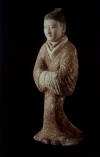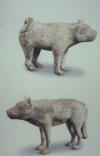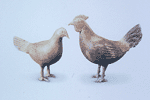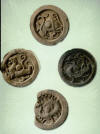Western Han Dynasty
Standing Woman
- female tomb figurine

Bronze Horse

Pair of Dogs

Chicken and Rooster

Xin Dynasty (Wang Mang Interregnum)
Beam Cap Tiles representing
North/South/East/West -
Dark Warrior (N), Vermillion Bird (S), Green Dragon (E),
White Tiger (W) :
 These four tiles were possibly part of a ceremonial building
constructed during the Wang Mang Interregnum (also referred
to as the "Xin" or "New" Dynasty), which divided the Han
dynasty into the earlier Western Han and the later Eastern
Han (after Wang Mang's brief rule 9 - 23 CE). Each
animal corresponds to one of the cardinal directions and is
associated with a particular color. The Northern
symbol (the Dark Warrior) is a combination of tortoise
and snake. The Southern bird appears to have a pearl
in its mouth. These tiles would have been placed over
the exposed ends of roof beams, thus slowing down the speed
with which the wood would decay.
These four tiles were possibly part of a ceremonial building
constructed during the Wang Mang Interregnum (also referred
to as the "Xin" or "New" Dynasty), which divided the Han
dynasty into the earlier Western Han and the later Eastern
Han (after Wang Mang's brief rule 9 - 23 CE). Each
animal corresponds to one of the cardinal directions and is
associated with a particular color. The Northern
symbol (the Dark Warrior) is a combination of tortoise
and snake. The Southern bird appears to have a pearl
in its mouth. These tiles would have been placed over
the exposed ends of roof beams, thus slowing down the speed
with which the wood would decay.
Eastern Han Dynasty
 Pigsty: This pigsty, from the latter or Eastern Han dynasty,
reflects the innovative way in which the Han dynasty
populace worked to conserve space and minimize waste and
pollution
Pigsty: This pigsty, from the latter or Eastern Han dynasty,
reflects the innovative way in which the Han dynasty
populace worked to conserve space and minimize waste and
pollution
Information on these Han dynasty
figures was adapted from: Eternal China ed. Li Jian;
Dayton Art Institute, 1998
pp. 103 - 181
|